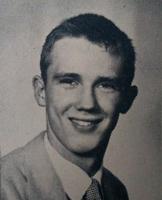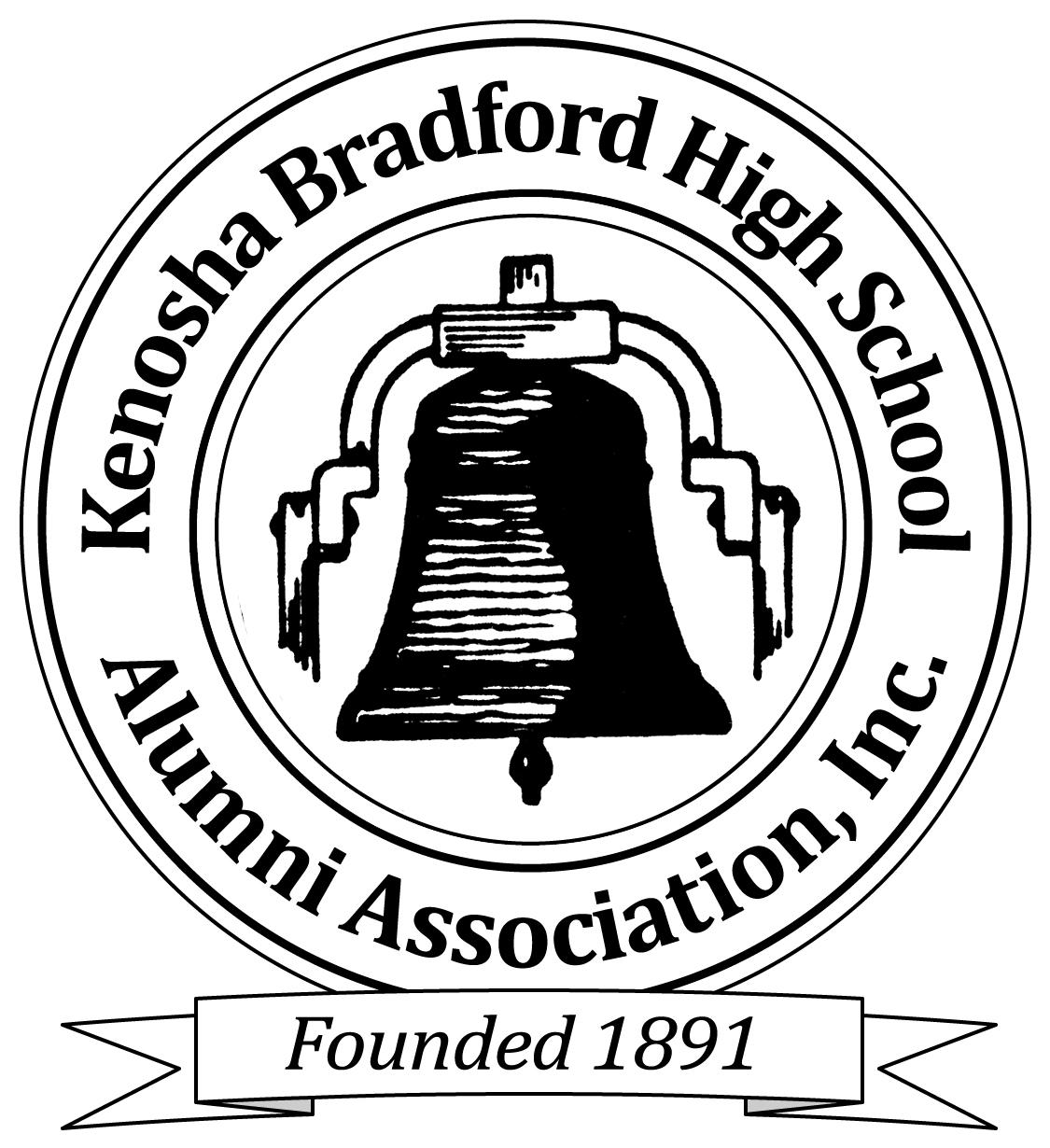
On September 21, 2016, David C. Pappas (pictured at right from the 1954 Spy) peacefully "slipped the surly bonds of Earth and now dances the skies on laughter-silvered wings" on the way to his reward, and perhaps even a "touch of the face of God" (John Magee) or, punishment or – nothing.
It all began when he was born to plain, poor, honest though slightly shady parents on March 18, 1936, in Kenosha, Wis.
David had a traditional Catholic grade school education where learning was punctuated by the Franciscan Nuns periodically convening miscreants in the music room on a weekly basis to dole out God's just desserts for their accumulated sins with well made yard sticks. Transgressions could include snowball fights at recess, blasphemy but most often, simply sass backs. He would further atone and make up to his God by serving as an altar boy.
To David, the world was filled with adventures all waiting to sign him on. When he was 13, he altered his birth certificate to show his age as 17 and boldly strode into the Naval Reserve headquarters and joined up. He loved the uniforms, being a sailor, going to the meetings and after two years rose to the rank of Seaman Apprentice with a quartermaster rating.
His first job at age 15 was as an after-hours janitor at an illegal horse race betting parlor buried deeply and inconspicuously in a commercial building in downtown Kenosha. His dad, a professional gambler, knew his way around that world and introduced David, to the people that made the illicit, not only acceptable, but reputable. He then attended MaryD.Bradford High School where he was a much less than average student. Once, when he failed to take an I.Q. test seriously and ended up with a score of 70, his high school counselor tried to shame him by telling him his score classified him as a "high grade moron." Always conscious of status, David asked her if "being high grade didn't at least count for something."
It was then he decided he would become a lawyer – a high grade moron a lawyer? – (back then an impossible dream for anyone with those academic credentials to aspire to, now it's commonplace). To everyone to whom he mentioned his dream, it triggered a lot of sniggling behind his back. But the University of Wisconsin must have seen something in him, because he was admitted to study philosophy and despite the naysayers, graduated with a Doctor of Law degree in January of 1961. Not totally certain what he would do with his law degree, he was sure it would be to aid and assist those of modest means who were being oppressed by the legal system. He had a profound love and respect for all animals and tried hard to follow the Janist Doctrine of doing no harm to any living thing. (The need for nourishment required him to exclude plants from his protection.) He often took on legal cases throughout his career in which the welfare and mistreatment of animals was an issue. He would be the voice of those who could not speak for themselves.
In 1961, looking for larger vistas where bigger issues were taking shape, he moved to Washington, DC, to be part of Kennedy's "Camelot" and became Staff Attorney for the United States Commission on Civil Rights, an agency created by Congress to periodically report to the President on the status of civil rights in the United States. His office was on Lafayette Park right across the street from the White House. He remembered standing at his bus stop at the end of the day on Pennsylvania Avenue waiting for his ride home to Silver Spring while the Cuban Missile Crisis was at its most dangerous apex. "Not a good place to be at that moment in history," he thought to himself, as he looked skyward for any signs of fiery streaking titanium tubes marked with a hammer and sickle heading towards earth.
When rumblings began about upcoming protests against segregation being planned by black students in Birmingham, AL, seeking to integrate the cities’ lunch counters, actions that could be counted on to lead to violence, he was sent to Birmingham in April 1963 to monitor and report on the situation. He would be called upon to seek a showdown between himself and the notorious segregationist Birmingham Police Commissioner "Bull" Conner. Also while there, he met and befriended Martin Luther King, Jr., spending evenings and mornings with him and his retinue as they helped the protestors with their strategic planning to ensure their activities would be constitutionally protected free speech should they end up in court. Robert Kennedy, then Attorney General, called Dr. King's room on the morning of the first protests to ask Dr. King to hold off, but Dr. King refused to take his call as he sat with David and others discussing the upcoming events. News of the violence, fire hoses and police dogs rocketed around the world, and the Birmingham protestors became the spark that lit the fires of the civil rights movement that followed and continues to this day.
In June, David was invited to and attend a reception at the White House hosted by the Kennedys in celebration of the one hundredth anniversary of the Emancipation Proclamation (1863-1963).
After two years in Washington, he returned to Madison one month before President Kennedy's assassination. At the time and for two years thereafter, he served as Assistant City Attorney for Madison before going into private practice. Always the ham, he enjoyed the drama and excitement of courtroom work, trials and appeals, where it seemed something new was always around the corner. In battles of wits between him and the judges, he always felt he was the better armed. In 2011, he was awarded Certificates of Merit by both the State Bar of Wisconsin and Dane County Bar Association for achieving and surviving 50 years in the practice of law.
Having grown up on Lake Michigan he always loved the water and took up sailing while in law school. Soon Lake Mendota was too small for him so he bought a 53-foot racing sailboat, the Falcon, and raced it successfully out of Milwaukee on Lake Michigan for 33 years. She won everything on the lake, setting records that still stand today. She was widely regarded as legendary and the most beautiful, fine-lined sailboat on the Great Lakes.
Soon even Lake Michigan got too small and David signed on to sail the "blue water;" across the Atlantic from Palma Majorca, Spain to Antigua; across the Indian Ocean from Phuket, Thailand to Djibouti, Africa, and across the Pacific from Hawaii to Pago Pago in the South Seas. Then, a chance to make the ultimate sailing passage, Rio de Janeiro to Chile around Cape Horn, every sailor's dream and nightmare, a passage of ten weeks, five thousand miles, and hundreds of hours of horror. Cape Horn could not be rivaled in its ferocity anywhere in the world. David returned from this passage around Cape Horn a far different man than when he departed. The poet John Masefield had it right when he wrote:
"Cape Horn, that tramples beauty into wreck and crumples steel and smites the strong man dumb."
He found profound and very moving a poem by a Spanish poet engraved on a plaque set in the tussock grass on the cliffs at Cape Horn in tribute to all the sailors who lost their lives in those wild seas:
"I am the albatross that waits for you, at the end of the world. I am the forgotten soul of the dead sailors lost rounding the Horn, from all the seas in the world. But they did not die in the wild seas. Today they fly on my wings toward eternity, in the high cry of the Antarctic winds." He relates tearing when he first saw that wind-blown, tussock covered hill and read those words. "Sailors have a special affinity," he used to say.
Pieced together, the miles he sailed were enough to circle the world. He obtained Master Mariner status and became a licensed Captain by the U.S. Coast Guard after having met extensive and demonstrated experience and testing requirements.
One problem with Falcon was it required a crew of 10 to effectively race. Lining up 10 good sailors for a full season schedule of racing became more and more difficult. He needed a recreational activity he could handle alone without needing others. Flying was the answer. He obtained his private pilot license, an instrument rating (highest score ever achieved on the written exam), a multi-engine rating and finally a commercial pilot's license. He loved flying his plane across the country and out over the ocean to the Bahamas and over Cuba to the Cayman Islands. He loved flying at night when the towns and cities glowed and glimmered beneath him in the darkness like "diamonds in a necklace."
A collector of oil paintings for many years, he decided to give it a go himself. He studied, took classes, worked hard and became proficient at producing tolerable representational paintings, mostly genre and seascapes. He held many exhibitions and was successful in having sold over 100 of his works, that now hang in collections across the country.
In July 2015, David published his first book, "The One-Eyed Albatross" a novel that chronicles his sailing passage, through an alter ego, around Cape Horn with all its danger and drama and includes autobiographical events that highlight parts of his life and career. The book is available worldwide through Amazon, Barnes & Noble, Ingram and on Kindle as well. It was recently featured at the Book Expo America at McCormick Place in Chicago and at the London Book Fair.
David is profiled on Who's Who in American Law, Who's Who in America (15 years) and Who's Who in the World. He was a member of the International Association of Cape Horner's, probably the most exclusive club in the world. To qualify, you must sail from 50 degrees South in one ocean, round Cape Horn, and then sail to 50 degrees South in the other ocean, one thousand and five hundred miles of the meanest water in the world. Then you have to prove you did it to be considered for membership. Daunting even to those of stout heart.
Recently, David had the pleasure of crossing sky jumping off his bucket list. He completed a jump in June.
David's fondness for animals led him to start the Sonny Boy Animal Sanctuary in Coloma, Wis. Their motto, "The sun always shines on the rainbow bridge," is also close to David's heart.
He is survived by his son, Christopher of Lodi, WI; his daughter, Andrea Pappas Atkins and her husband and son-in-law, Dan of Madison, WI; his ex-wife and final caretaker, Laurie Pappas Boss; his nephew, Ted Pappas and his wife, Fie of Wauwatosa, WI; his beloved companions, "Sonny-Boy", a Pomeranian and "Amber", a Poodle as well as his beloved cats, "Constanzia" (named after Mozart's wife) and "Dennis" named after "the menace." David says he'll wait for them on the Rainbow Bridge.
Memorial donations may be made to Sonny Boy Animal Sanctuary or Best Friends Animal Sanctuary.
Published on Madison.com October 1, 2016

